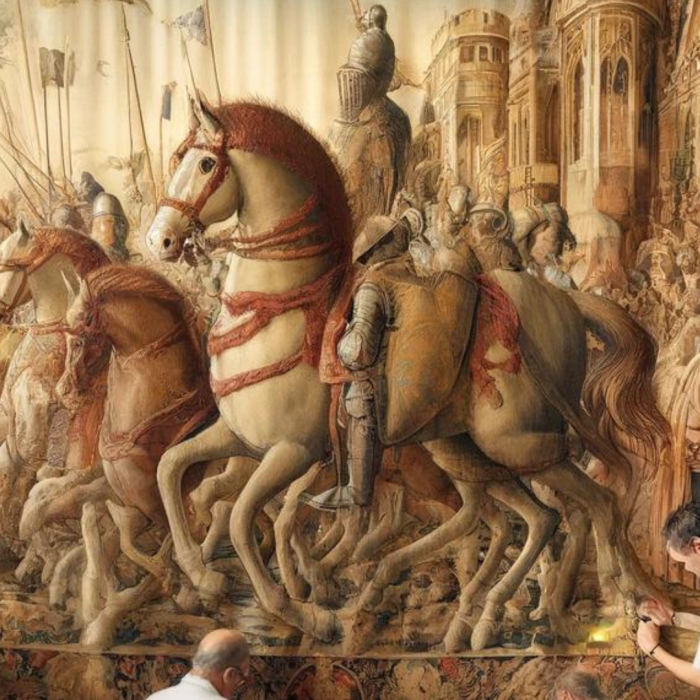The role of Tapestries in Religious Settings
Tapestries are large, decorative textile pieces typically woven by hand or on a loom. They often feature intricate designs, patterns, and imagery, making them popular for adding visual interest and warmth to interior spaces. Historically, tapestries served both practical and aesthetic purposes. They were used to insulate rooms, depict stories or historical events, showcase wealth and status, and enhance the overall ambiance of a space.
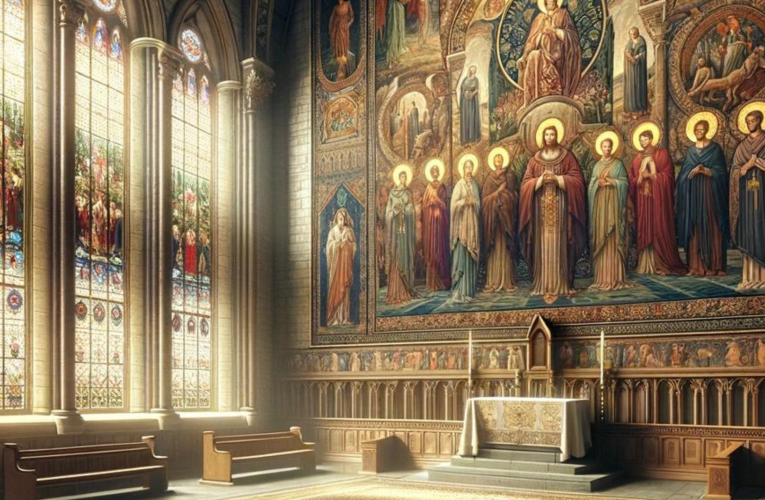
Importance of Interior Design in Religious Settings
Interior design plays a crucial role in religious settings as it helps create an atmosphere conducive to worship, meditation, and community gathering. Here are several reasons why interior design is significant in religious spaces:
- Reflecting Beliefs and Values: The interior design of a religious space often reflects the beliefs, values, and cultural heritage of the community it serves. Elements such as colors, symbols, and architectural features can convey important spiritual messages and create a sense of belonging for worshippers.
- Enhancing Sacredness: Thoughtful interior design can enhance the sacredness of a religious setting. The choice of materials, lighting, layout, and decor can contribute to a tranquil and reverent environment that encourages contemplation and spiritual connection.
- Fostering Community and Unity: Religious spaces are places where communities come together to worship and share experiences. Effective interior design can facilitate this sense of community by providing comfortable seating, optimizing acoustics for prayers and ceremonies, and creating spaces for social interaction and fellowship.
- Supporting Rituals and Ceremonies: Interior design elements such as altars, podiums, prayer rugs, and religious artworks like tapestries play a vital role in supporting rituals and ceremonies. These elements help focus attention, guide worship practices, and add beauty and meaning to religious gatherings.
- Evoking Emotions and Inspiration: Well-designed religious interiors have the power to evoke emotions such as awe, reverence, peace, and inspiration. Tapestries, in particular, with their intricate designs and storytelling capabilities, can evoke a sense of wonder and spiritual contemplation among worshippers.
Historical Significance of Tapestries in Religious Contexts
A. Origins and Evolution of Tapestries in Religious Spaces
Tapestries have played a significant role in religious settings throughout history, with their origins dating back to ancient civilizations such as Egypt, Greece, and Rome. However, it was during the medieval and Renaissance periods that tapestries gained immense popularity in religious contexts.
- Medieval Period: In medieval Europe, tapestries were used in churches, cathedrals, and monasteries to adorn the walls and create a visually rich environment for worship. These tapestries were often woven with intricate designs depicting biblical stories, saints, and religious motifs. They served not only as decorative elements but also as educational tools, helping to convey religious teachings to the illiterate masses.
- Renaissance Period: The Renaissance saw a flourishing of tapestry production, with workshops in cities like Brussels, Paris, and Florence producing exquisite pieces for churches and noble residences. Religious tapestries became larger in size and more detailed in design, showcasing scenes from the Old and New Testaments, the lives of saints, and the miracles of Christ.
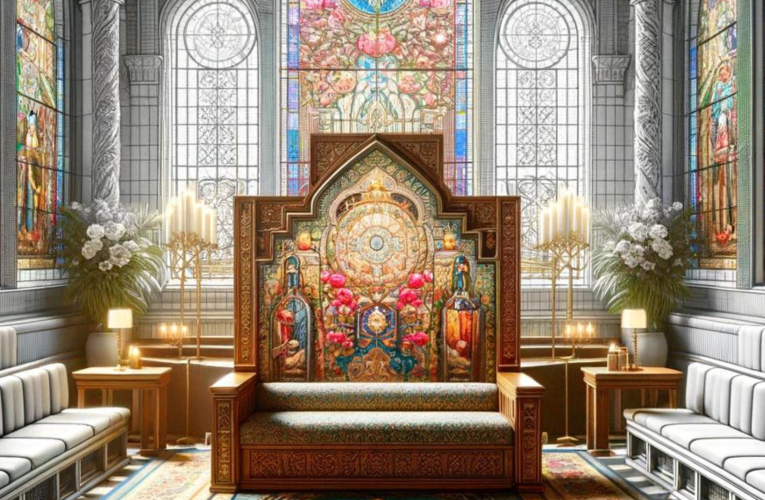
B. Symbolism and Storytelling in Religious Tapestries
Symbolism: Religious tapestries are rich in symbolism, with each element carefully chosen to convey spiritual meanings. For example, the use of colors such as gold symbolizes divine light and purity, while motifs like the lamb represent Christ’s sacrifice and redemption. These symbols were not just decorative but carried profound theological messages, enriching the religious experience of worshippers.
Storytelling: One of the primary functions of religious tapestries was to narrate biblical stories and religious narratives. Artists and weavers depicted scenes such as the Nativity, the Crucifixion, and the Last Supper in intricate detail, capturing pivotal moments in Christian theology. The use of tapestries as storytelling devices helped engage worshippers visually, allowing them to connect with sacred narratives on a deeper level.
The Role of Tapestries in Interior Design Style of Religious Spaces
Tapestries play a significant role in enhancing the aesthetic appeal and spiritual ambiance of religious spaces. In this section, we will delve into the influence of tapestries on the overall decor, their ability to enhance spiritual ambiance, and how they can be integrated with architectural elements to create a harmonious interior design style.
A. Influence of Tapestries on Overall Decor
Tapestries are not merely decorative items but are also symbolic representations of religious narratives, themes, and cultural heritage. In religious settings, tapestries can dramatically transform the ambiance of a space by adding depth, color, and texture to the decor. They serve as focal points that draw attention and create a sense of reverence and awe among worshippers.
The intricate designs, vibrant colors, and historical motifs woven into tapestries can complement other elements of the interior decor, such as furniture, lighting fixtures, and wall art. Whether depicting biblical scenes, religious symbols, or ornate patterns, tapestries contribute to the visual richness of the surroundings, making them essential components of religious interior design style.
B. Enhancement of Spiritual Ambiance
One of the most remarkable aspects of tapestries in religious spaces is their ability to enhance the spiritual ambiance. As worshippers enter a sacred place adorned with tapestries, they are greeted by narratives that resonate with their faith, beliefs, and cultural heritage. The presence of tapestries creates a meditative atmosphere, encouraging contemplation, prayer, and spiritual connection.
Moreover, tapestries have a profound storytelling aspect that transcends language barriers. They convey timeless messages and parables through visual artistry, engaging the senses and emotions of those who experience them. This emotional resonance contributes significantly to the overall spiritual experience within religious interiors, fostering a sense of unity and reverence among the congregation.
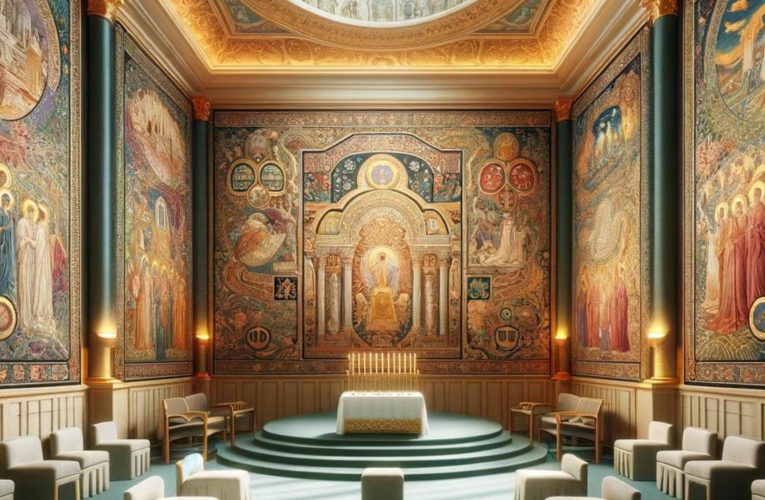
C. Integration with Architectural Elements
To fully leverage the impact of tapestries in religious settings, it is essential to integrate them seamlessly with architectural elements. Tapestries can be strategically hung on walls, draped over altars, or displayed as banners, aligning with the architectural layout of the space. By harmonizing tapestries with architectural features such as arches, columns, and vaulted ceilings, designers create a cohesive visual narrative that reinforces the religious theme.
Furthermore, the lighting design plays a crucial role in highlighting the beauty and intricacy of tapestries. Soft ambient lighting or focused spotlights can accentuate specific details and textures, adding depth and dimension to the overall interior design. This integration of tapestries with architectural elements and lighting techniques elevates the spiritual experience, making religious spaces more immersive and inspiring.
Types of Religious Tapestries and Their Meanings
Let’s break down the different types of religious tapestries and their meanings in the context of interior design and religious settings.
A. Biblical scenes and narratives:
One of the most common themes found in religious tapestries is depicting biblical scenes and narratives. These tapestries often illustrate stories from religious texts such as the Bible, Quran, or Hindu scriptures. For example, scenes from the life of Jesus Christ, the story of Adam and Eve, or the journey of the Prophet Muhammad may be depicted in intricate detail.
In interior design, tapestries with biblical scenes can add a sense of spirituality and historical depth to a religious setting. They serve as visual representations of faith and can create a sacred atmosphere within churches, mosques, temples, or other places of worship. Additionally, in homes or spaces where religious individuals gather for prayer or meditation, these tapestries can enhance the ambiance and reinforce spiritual beliefs.
B. Religious symbolism and iconography:
Many religious tapestries feature symbolic imagery and iconography that hold specific meanings within different faith traditions. For example, Christian tapestries might include symbols like the cross, the dove (symbolizing the Holy Spirit), or the lamb (representing Jesus Christ). In Islamic tapestries, you might find geometric patterns, Arabic calligraphy with verses from the Quran, or motifs like the star and crescent.
In terms of interior design style, religious symbolism in tapestries can be incorporated into various decor themes. For instance, a modern minimalist interior with a Christian tapestry featuring a simple cross design can create a focal point that subtly reflects the homeowner’s faith. Similarly, a traditional Islamic tapestry with intricate geometric patterns can complement a Middle Eastern-inspired decor scheme, adding richness and cultural significance to the space.
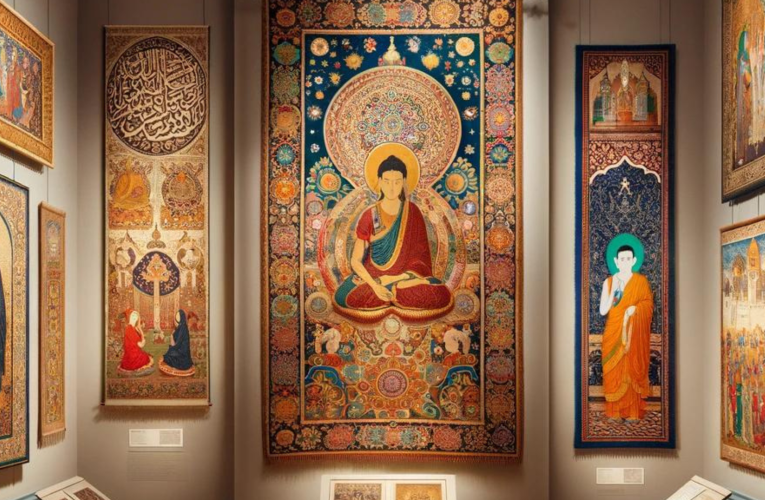
C. Cultural variations in religious tapestry designs:
Religious tapestries also vary in design based on cultural influences and traditions. Different regions and religious communities have unique artistic styles and preferences when it comes to depicting religious themes in tapestry art. For example, Tibetan Buddhist tapestries often feature mandalas and vibrant colors, while Jewish tapestries might include motifs like the Star of David or scenes from Jewish history.
In interior design, incorporating culturally diverse religious tapestries can celebrate diversity and promote inclusivity in religious settings. Mixing tapestries from various traditions can create an eclectic yet harmonious ambiance, showcasing the beauty of different faiths coming together in a shared space. It allows individuals to connect with their heritage and spiritual beliefs while appreciating the artistry and cultural richness behind each tapestry.
Overall, religious tapestries play a significant role in interior design, especially within religious settings. They not only enhance the aesthetic appeal of a space but also convey meaningful narratives, symbols, and cultural nuances that resonate with believers and visitors alike.
Modern Trends in Using Tapestries for Religious Interior Design
In recent years, there has been a noticeable shift in the use of tapestries for religious interior design, with contemporary interpretations of religious themes, a focus on sustainable and eco-friendly tapestry materials, and the rise of customized tapestries for specific religious practices. These trends reflect a deeper understanding of the role of tapestries in enhancing the ambiance and spiritual experience within religious settings.
A. Contemporary Interpretations of Religious Themes
One of the modern trends in using tapestries for religious interior design is the reinterpretation of traditional religious themes in a contemporary context. Artists and designers are exploring innovative ways to depict religious motifs and symbols, blending traditional iconography with modern artistic techniques.
For example, tapestries featuring abstract representations of religious figures or symbolic elements are becoming increasingly popular. These abstract designs allow for a more nuanced and inclusive interpretation of religious themes, appealing to a diverse range of worshippers and contributing to a more harmonious and peaceful environment within religious spaces.
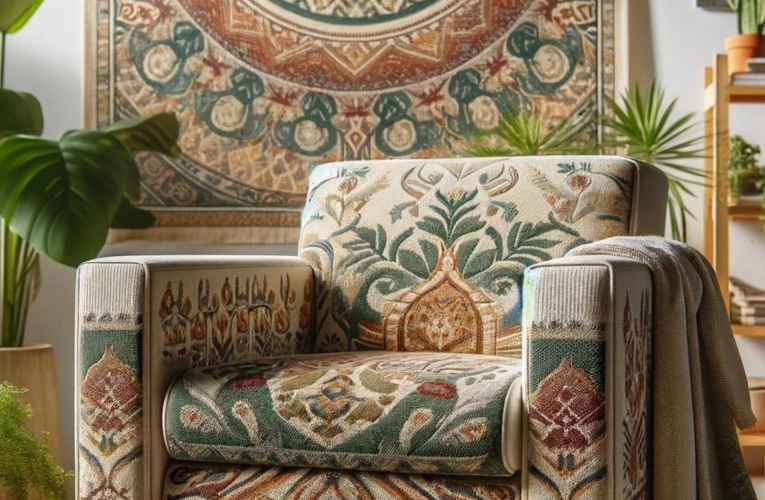
B. Sustainable and Eco-friendly Tapestry Materials
Another significant trend in tapestry usage for religious interior design is the emphasis on sustainable and eco-friendly materials. With growing awareness of environmental issues, religious institutions and interior designers are opting for tapestries made from organic fibers, recycled materials, and natural dyes.
By choosing sustainable tapestry materials, religious settings can reduce their environmental impact while creating a sense of connection to nature and promoting a message of stewardship and respect for the planet. These eco-friendly tapestries also often have a unique texture and aesthetic appeal, adding depth and character to the interior design of religious spaces.
C. Customized Tapestries for Specific Religious Practices
Customization is another key trend in using tapestries for religious interior design. Religious institutions are commissioning customized tapestries that reflect their specific beliefs, practices, and cultural heritage. These custom designs may include sacred scriptures, religious symbols, or historical narratives that hold significance for the community.
By incorporating customized tapestries into their interior decor, religious settings can create a more immersive and meaningful experience for worshippers. These tapestries serve as visual reminders of shared values and traditions, fostering a sense of identity and unity among believers.
In conclusion, the role of tapestries in religious settings has evolved to encompass contemporary interpretations of religious themes, sustainable and eco-friendly materials, and customized designs tailored to specific religious practices. These modern trends not only enhance the aesthetic appeal of religious interior design but also contribute to a deeper spiritual experience for worshippers, creating spaces that inspire reverence, contemplation, and connection.
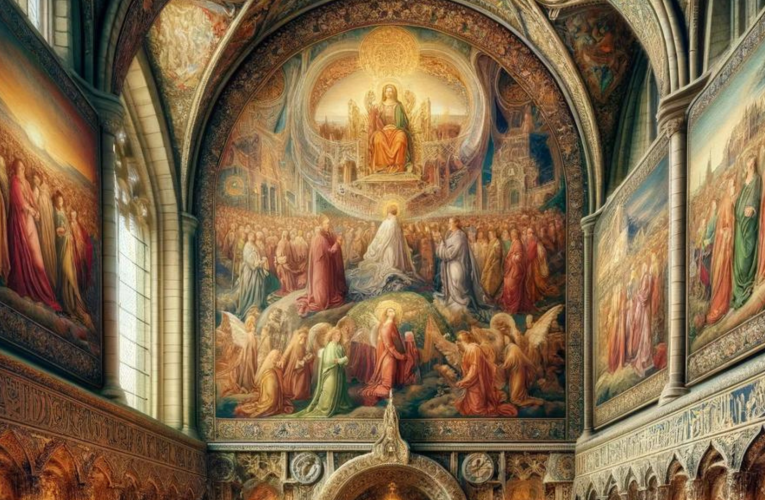
Practical Considerations in Incorporating Tapestries into Religious Settings
Tapestries have long played a significant role in religious settings, adding beauty, symbolism, and historical depth to interior design. In this article, we will delve into practical considerations when incorporating tapestries into religious spaces, focusing on size, placement, lighting, maintenance, preservation, and budget-friendly procurement options.
A. Size, Placement and Lighting Considerations:
- Size: Consider the dimensions of the space where the tapestry will be displayed. Choose a size that complements the area without overwhelming it.
- Placement: Decide on the optimal placement to ensure visibility and impact. Consider focal points such as altars, prayer spaces, or sanctuary walls.
- Lighting: Proper lighting is crucial to highlight the tapestry’s details and enhance its visual appeal. Use adjustable lighting to control brightness and create the desired ambiance.
B. Maintenance and Preservation of Religious Tapestries:
- Regular Cleaning: Develop a cleaning schedule to remove dust and dirt from the tapestry. Use gentle methods such as vacuuming or light brushing to avoid damage.
- Climate Control: Maintain stable humidity and temperature levels to prevent mold, fading, or deterioration of the fabric.
- Conservation Techniques: Consult with experts on conservation techniques such as framing, backing, or using UV-protective materials to preserve tapestries for the long term.
C. Budget-Friendly Options for Tapestries Procurement:
- Reproductions: Consider high-quality reproductions of famous religious tapestries, which are often more affordable than originals.
- Custom Designs: Work with local artists or designers to create custom tapestries that reflect the religious themes and interior design style of the space.
- Online Platforms: Explore online platforms specializing in religious décor and interior design, where a wide range of tapestries at various price points can be found.
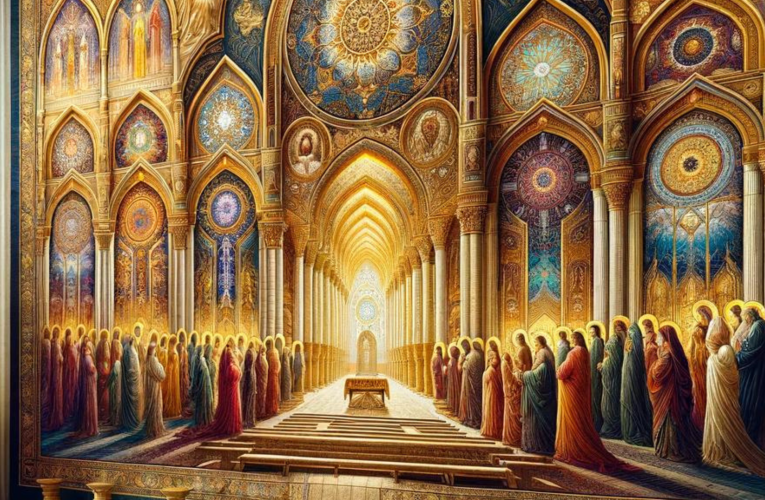
Notable Religious Spaces with Emphasis on Tapestries
In exploring the role of tapestries in religious settings, it’s crucial to delve into specific case studies that highlight the significance of these textiles in enhancing the ambiance and spiritual experience within churches, mosques, temples, and other sacred spaces. Here, we’ll examine notable examples and the impact of tapestries on visitor experience and spiritual connection.
A. Examples of Churches, Mosques, Temples, etc., with Significant Tapestry Use
- The Vatican Museums, Vatican City: The Vatican Museums boast an extensive collection of tapestries dating back to the Renaissance and Baroque periods. One of the most famous sets is the Acts of the Apostles series, designed by Raphael’s workshop. These tapestries, with their intricate designs and biblical narratives, adorn the walls of the Vatican’s galleries and contribute to the rich religious and artistic heritage of the space.
- The Sheikh Zayed Grand Mosque, Abu Dhabi: This magnificent mosque features stunning tapestries and carpets throughout its interior. The handwoven carpets, particularly the massive one in the main prayer hall, showcase intricate floral patterns and Islamic geometric motifs, creating a serene and harmonious atmosphere for worshippers.
- Chartres Cathedral, France: Known for its medieval stained glass windows, Chartres Cathedral also houses remarkable tapestries that add to its spiritual allure. The “Apocalypse Tapestry,” depicting scenes from the Book of Revelation, is a notable example that captivates visitors with its detailed storytelling and vibrant colors.
- The Golden Temple, Amritsar: In Sikhism, tapestries play a significant role in gurdwaras (Sikh temples). The Golden Temple in Amritsar features intricately embroidered tapestries and wall hangings that depict Sikh history, teachings, and cultural motifs. These textiles not only enhance the temple’s aesthetic but also convey profound spiritual messages.
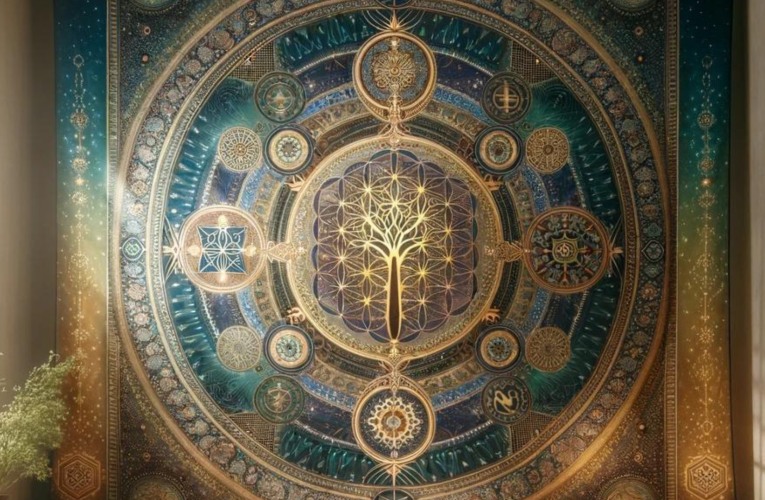
B. Impact of Tapestries on Visitor Experience and Spiritual Connection
- Enhanced Ambiance: Tapestries contribute to the overall interior design style of religious spaces, adding warmth, texture, and visual interest. Their vibrant colors and intricate patterns create a sense of awe and reverence, setting the stage for a meaningful spiritual experience.
- Historical and Cultural Significance: Many tapestries in religious settings depict historical events, religious narratives, or cultural symbols. These textiles serve as educational tools, allowing visitors to connect with the traditions, beliefs, and stories associated with the faith or institution.
- Symbolism and Inspiration: The imagery portrayed in tapestries often carries symbolic meaning, inspiring contemplation and reflection among visitors. Whether depicting biblical scenes, sacred geometry, or cultural motifs, these artworks can evoke deep spiritual emotions and facilitate a sense of connection to the divine.
- Acoustic Benefits: Beyond their visual impact, tapestries also contribute to acoustics within religious spaces by absorbing sound and reducing echoes. This can create a more peaceful and conducive environment for prayer, meditation, and worship.



